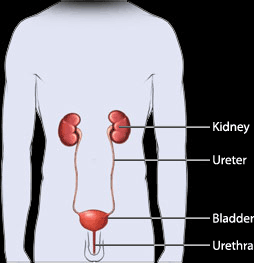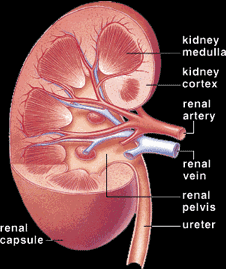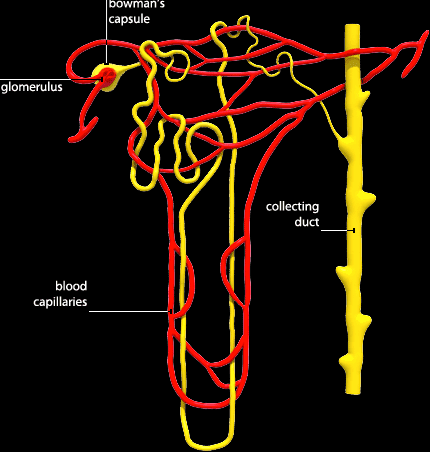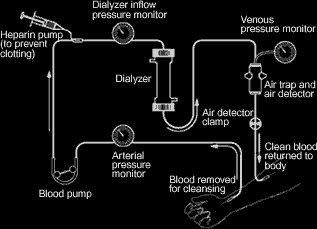Excretion in Humans
Excretion is the removal of toxic materials, the waste products of metabolism and substance in excess of requirements from organisms. Metabolism is chemical reactions taking place inside cells, including respiration. The body excretes three main waste materials. These are Carbon Dioxide, Urea and Water. Excretion is a very important feature to us because without it toxic substances will build up in our bodies and kill us. It also helps in maintaining the composition of body fluids. The Excretory System of humans is made up of 4 structures: Two kidneys, two ureters, a bladder, and the urethra. The kidneys act as a filter to filter the waste products from the blood, the ureters are tubes that transport the main waste products (urine) from the kidneys to the bladder, where it is stored until it is excreted out of the body through the urethra. |
 |
Formation of Urea:
- When you eat a food high in protein, it is digested in the small intestine into amino acids.
- The villi on the walls of the small intestine absorb the amino acids into the hepatic portal vein.
- Hepatic portal vein is a special vein that transports digested material from the small intestine to the liver.
- The liver plays a big role in maintaining the level of protein in our body. It absorbs all amino acids from the hepatic portal vein. If the body needs proteins, they will pass through the liver into the blood stream to be used by the body cells to make protein.
- If the body does not need proteins. The liver will absorb excess amino acids and break them down into carbohydrates and nitrogen. The formula of amino acids is CHON; here we remove the nitrogen from the molecule, to get a carbohydrate. This is called deamination. Nitrogen is made into urea which is a nitrogenous waste product.
- The products are then released to the blood stream.
Kidneys Structure:A kidney consists of two main structures:
Between the cortex and the Medulla, there is a structure called the nephrone. In the centre of the kidney there is a cavity called the pelvis which leads to the ureter. |
 |
Structure of Nephrone:
The nephrone starts with a cup shaped structure called Bowman’s capsule. Inside the Bowman’s capsule there is a very dense network of blood capillaries entering as capillaries from the renal artery and exiting as capillaries from the renal vein. This dense network of capillaries is called Glomerulus. The rest of the nephrone is a long coiled tube where materials filtered from the blood flow in. At some point the coiled tube becomes straight and is bent in a U shape tube, this part is called loop of Henle and it is surrounded by a network of capillaries from the renal vein, it is where reabsorption takes place. All nephrones end at a large tube called the Collecting duct where content of the nephrones are transported to the pelvis, to be secreted in the ureter.

Mechanism of the Kidneys:
Ultrafiltration:
The blood in the renal artery contains large amounts of urea, glucose, water, mineral ions and some amino acids. When it reaches the glomerulus, the high pressure of the blood and the concentration gradient of these materials between the blood and the nephrone cause most of these substances to diffuse from the blood to the bowman’s capsule and become content of the nephrone, which is called glomerular filtrate (glomerular filtrate is a mixture of urea, water, glucose and mineral ions that diffused from the blood to the nephrone).
Reabsorption:
The glomerular filtrate moves in the nephrone till it reaches the loop of henle, which is surrounded by a dense network of blood capillaries of the renal vein. Here there is a concentration gradient of the content of the content of nephrone between the nephrone and blood. Both diffusion and active transport occur to ensure the complete reabsorption of valuable substances from the glomerular filtrate back to the blood; these substances are glucose and amino acids. Some water also moves by osmosis to the blood, as well as minerals.
That leaves urea, excess water and minerals to continue in the nephrone till it reaches the collecting duct and the pelvis. This mixture is called urine. Urine is transported from the pelvis to the urinary bladder by the ureters. It is them secreted out of the body through the urethra.
Dialysis:If a person gets a kidney failure, which means his kidneys cannot function anymore, they have to wash their blood on regular basis with a machine that is an alternative to the damaged kidneys. This process is called dialysis. During this process, a tube is attached to the patient’s vein; the tube is attached to the dialysis machine on the other end. There is another tube coming out of the machine to the patient’s vein. The blood is sucked from the patient’s vein, it goes through the machine, and out from the other side back to the patient’s vein. When the blood enters the dialysis machine, it is very rich in waste materials (urea, excess water and minerals). The tubes inside the dialysis machine are made of a partially permeable membrane to allow diffusion. The tubes are also surrounded with dialysis fluid |
 |
| which is the same as blood plasma. The concentration of waste products in the blood is much higher in the blood than in the dialysis fluid. This creates a concentration gradient, diffusion occurs and waste products leave the blood to the dialysis fluid, which then exists the machine and gets disposed. The dialysis fluid has to be renewed continuously to keep the concentration gradient of waste products higher in the blood, thus ensuring that all waste products leave the blood. The clean blood is then returned to the patient’s vein. | |